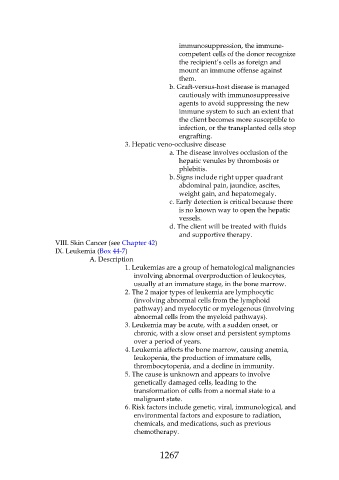Page 1267 - Saunders Comprehensive Review For NCLEX-RN
P. 1267
immunosuppression, the immune-
competent cells of the donor recognize
the recipient’s cells as foreign and
mount an immune offense against
them.
b. Graft-versus-host disease is managed
cautiously with immunosuppressive
agents to avoid suppressing the new
immune system to such an extent that
the client becomes more susceptible to
infection, or the transplanted cells stop
engrafting.
3. Hepatic veno-occlusive disease
a. The disease involves occlusion of the
hepatic venules by thrombosis or
phlebitis.
b. Signs include right upper quadrant
abdominal pain, jaundice, ascites,
weight gain, and hepatomegaly.
c. Early detection is critical because there
is no known way to open the hepatic
vessels.
d. The client will be treated with fluids
and supportive therapy.
VIII. Skin Cancer (see Chapter 42)
IX. Leukemia (Box 44-7)
A. Description
1. Leukemias are a group of hematological malignancies
involving abnormal overproduction of leukocytes,
usually at an immature stage, in the bone marrow.
2. The 2 major types of leukemia are lymphocytic
(involving abnormal cells from the lymphoid
pathway) and myelocytic or myelogenous (involving
abnormal cells from the myeloid pathways).
3. Leukemia may be acute, with a sudden onset, or
chronic, with a slow onset and persistent symptoms
over a period of years.
4. Leukemia affects the bone marrow, causing anemia,
leukopenia, the production of immature cells,
thrombocytopenia, and a decline in immunity.
5. The cause is unknown and appears to involve
genetically damaged cells, leading to the
transformation of cells from a normal state to a
malignant state.
6. Risk factors include genetic, viral, immunological, and
environmental factors and exposure to radiation,
chemicals, and medications, such as previous
chemotherapy.
1267

